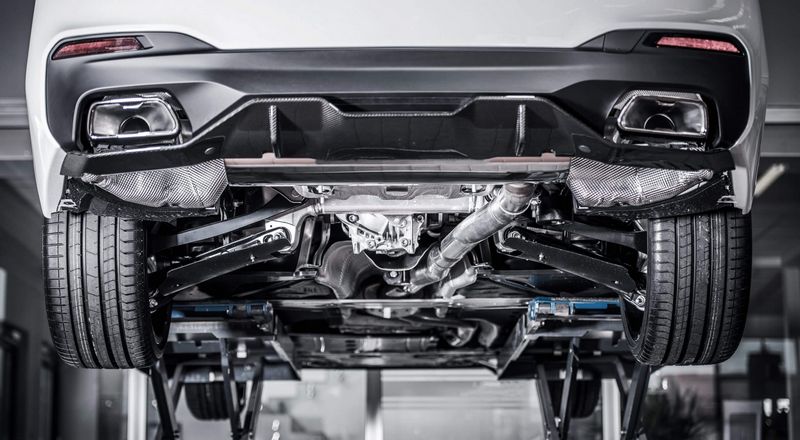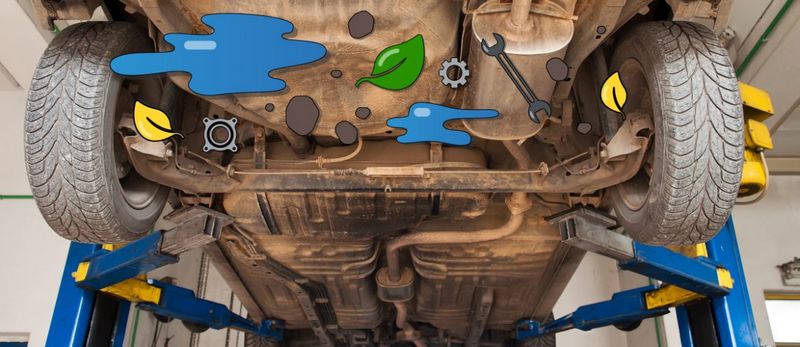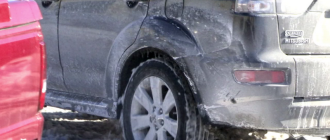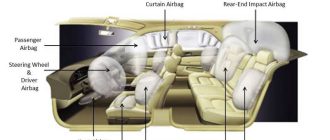
The Importance of Regularly Checking Your Car’s Undercarriage for Damage
Regularly checking your car’s undercarriage for damage is an essential part of vehicle maintenance. The undercarriage is one of the most vulnerable areas of your car, constantly exposed to road debris, potholes, and harsh weather conditions. Ignoring damage to this area can lead to serious safety issues and expensive repairs in the long run.
By regularly inspecting your car’s undercarriage, you can identify potential problems early on. This includes checking for signs of rust, leaks, loose parts, or wear and tear. Addressing these issues promptly can prevent them from worsening and causing further damage to other components of your car.
Checking your car’s undercarriage should be done as part of your routine vehicle maintenance. This ensures that you catch any issues before they become more significant problems that could compromise the safety and performance of your car. Take the time to familiarize yourself with your car’s undercarriage and what to look for when inspecting it.
Remember, prevention is always better than cure, and regularly checking your car’s undercarriage for damage is a proactive way to stay safe on the road.
Investing time in inspecting your car’s undercarriage is worth it in the long run. It can save you money on repairs and give you peace of mind knowing that your vehicle is in good working condition. So, don’t neglect this important aspect of car maintenance. Make it a habit to regularly check your car’s undercarriage for damage, and keep yourself and others safe on the road.
Why Regular Inspections Are Essential
The importance of regularly checking your car’s undercarriage for damage cannot be overstated. Regular inspections are essential to ensure the safety and reliability of your vehicle. By regularly checking the undercarriage, you can identify any potential issues and address them before they become major problems.
Regular inspections help to prevent potential accidents and breakdowns. Damage to the undercarriage can compromise the structural integrity of your car, leading to safety concerns on the road. By catching these issues early on, you can avoid potentially dangerous situations and keep yourself and others safe while driving.
Regular inspections can save you money in the long run. By identifying and fixing minor damages early, you can prevent them from becoming major issues that require expensive repairs. Regular inspections also help to extend the lifespan of your car, allowing you to get the most out of your investment.
Overall, checking your car’s undercarriage for damage regularly is a crucial part of responsible car ownership. By taking the time to inspect your car and address any issues, you can ensure the safety and performance of your vehicle for years to come.
Identifying Common Issues
Regularly checking your car’s undercarriage for damage is important to ensure your safety on the road. By inspecting these areas, you can identify common issues that may pose a risk to your vehicle’s performance. Here are some common issues to look out for:
- 1. Rust and Corrosion – The undercarriage of your car is exposed to moisture, road salt, and other corrosive substances, which can cause rust and corrosion over time. Check for any signs of rust or corrosion, such as discoloration or flaking paint.
- 2. Leaks – Inspect the undercarriage for any signs of fluid leaks, such as oil, coolant, or brake fluid. Leaks can indicate a problem with your car’s engine or other systems, and should be addressed promptly to prevent further damage.
- 3. Damage to Exhaust System – Look for any damage or loose components in your car’s exhaust system, including the muffler, pipes, and catalytic converter. Damage to these components can affect the performance and fuel efficiency of your vehicle.
- 4. Suspension Issues – Check for any signs of damage or wear on your car’s suspension system, including the shocks, struts, and control arms. Issues with the suspension can result in poor handling and an uncomfortable ride.
- 5. Loose or Damaged Heat Shields – Heat shields are designed to protect the undercarriage of your car from excessive heat generated by the engine and exhaust system. Inspect them for any signs of damage or looseness, as they play a crucial role in preventing fires.
- 6. Brake Line Integrity – Ensure that your car’s brake lines are free from damage or leaks. Any issues with the brake lines can compromise the effectiveness of your braking system, posing a serious safety risk.
By regularly checking your car’s undercarriage for these common issues, you can address them promptly and prevent further damage. This will help ensure your car remains safe and reliable on the road.
Rust and Corrosion Prevention
Regularly checking your car’s undercarriage for damage is essential for preventing rust and corrosion. Rust can eat away at the metal components of your vehicle, compromising its structural integrity and safety. Corrosion, on the other hand, can damage the electrical and mechanical systems of your car, leading to costly repairs.
One of the main causes of rust and corrosion is exposure to moisture, especially saltwater. If you live in an area with a high humidity level or near the coast, your car is more susceptible to rust and corrosion. Checking the undercarriage regularly allows you to identify and address any signs of damage before they become severe.
When checking your car’s undercarriage, pay attention to any signs of rust or corrosion. Look for bubbling or peeling paint, as this can be an indication of rust underneath. Inspect the brake lines, fuel lines, and exhaust system for any signs of corrosion. It’s also important to check the frame and suspension components for rust or weakening due to corrosion.
Prevention is key when it comes to rust and corrosion. Here are some tips to help you protect your car’s undercarriage:
- Wash your car regularly, paying extra attention to the undercarriage. Removing dirt, salt, and other debris can help prevent rust and corrosion.
- Apply a rust-proofing treatment to your car’s undercarriage. This can provide an extra layer of protection against moisture and salt.
- Consider adding an undercoating to your car. This can help prevent moisture from seeping into the metal components and causing rust.
- Keep your car’s drains and drainage channels clear of debris to ensure proper water drainage.
- Inspect your car’s undercarriage after driving on roads that have been treated with salt or chemicals in the winter. Salt can accelerate the rusting process, so it’s important to remove any traces of it as soon as possible.
By regularly checking your car’s undercarriage for damage and taking preventive measures, you can significantly prolong the lifespan of your vehicle and ensure your safety on the road.
The Dangers of Driving with Undercarriage Damage
Driving with undercarriage damage can pose significant risks to your safety on the road. The undercarriage is one of the most critical components of your car, as it holds many essential parts such as the fuel tank, exhaust system, and suspension.
If you neglect to regularly check your car’s undercarriage for damage, it can lead to various dangers. The first danger is a compromised fuel tank. When the undercarriage is damaged, the fuel tank can be exposed, making it vulnerable to punctures and leaks. This can result in fuel leakage and a potential fire hazard.
An additional danger of driving with undercarriage damage is an impaired exhaust system. If the undercarriage is compromised, the exhaust system may hang lower than it should, increasing the risk of it dragging on the road. This can lead to a damaged exhaust system, which can cause harmful fumes to enter the car’s interior, posing a threat to your health.
The undercarriage damage can also affect the suspension system of your car. A damaged suspension can lead to decreased stability and compromised handling, making it challenging to control the vehicle, especially in emergency situations.
Driving with undercarriage damage can also worsen existing issues. For instance, if your car already has alignment problems, driving with undercarriage damage can exacerbate these issues. This can result in uneven tire wear and poor handling, further compromising your safety on the road.
Regularly checking your car’s undercarriage for damage is crucial to ensure your safety while driving. By addressing any issues promptly, you can prevent accidents, avoid unnecessary repairs, and prolong the lifespan of your vehicle.
- Inspecting the undercarriage for signs of rust, dents, or leaks.
- Checking for any loose or hanging parts.
- Examining the suspension system for signs of damage or wear.
- Taking your car to a professional mechanic for a thorough inspection.
Remember, maintaining a well-functioning undercarriage is a vital part of responsible car ownership. By regularly checking for undercarriage damage and addressing any issues promptly, you can stay safe on the road and enjoy a smooth driving experience.
Importance of Suspension Inspection
When it comes to the damage and wear on your car’s undercarriage, one of the most important areas to check regularly is the suspension system. The suspension system plays a crucial role in ensuring a smooth and safe ride, as it helps to absorb shocks, maintain stability, and keep your tires in contact with the road.
Regularly checking the suspension system for any signs of damage or wear is essential for several reasons. First and foremost, a damaged or worn suspension can greatly affect your car’s handling and stability, making it more difficult to control and potentially causing accidents. It can also lead to uneven tire wear, reducing the lifespan of your tires and costing you more money in the long run.
Additionally, a faulty suspension system can negatively impact other components of your car, such as the brakes and steering. If the suspension is not properly functioning, it can put extra strain on these systems, increasing the risk of failure and compromising your safety on the road.
Regular suspension inspections can help you catch any potential issues early on and address them before they become major problems. During an inspection, a mechanic will check for any signs of damage, such as leaks, worn-out bushings, or broken components. They will also assess the overall condition of the suspension system, ensuring that it is properly aligned and functioning as it should.
In conclusion, checking your car’s undercarriage for damage is crucial, and the suspension system should not be overlooked. Regular suspension inspections can help ensure your safety on the road by maintaining proper handling, stability, and tire wear. Don’t neglect this important aspect of car maintenance and schedule regular inspections to catch and address any suspension issues that may arise.
Protecting Your Vehicle’s Resale Value
Regularly checking your car’s undercarriage for damage is not only important for staying safe on the road, but it can also help protect your vehicle’s resale value. By keeping your undercarriage in good condition, you can ensure that potential buyers see your car as well-maintained and worth its value.
When buyers are considering purchasing a used car, one of the first things they will look at is the condition of the undercarriage. Any signs of damage or neglect can raise concerns about the overall condition of the vehicle. Therefore, it is crucial to check and address any issues with the undercarriage regularly.
A well-maintained undercarriage signifies that the car has been properly cared for and is less likely to have hidden issues or previous damage. This can give buyers confidence in the reliability and longevity of the vehicle, ultimately increasing its resale value.
Regular inspections of the undercarriage allow you to catch any potential problems early on. This gives you the opportunity to address them before they worsen and potentially cause more significant damage. By dealing with issues promptly, you can prevent further damage and costly repairs down the line.
Additionally, keeping your undercarriage clean and free of debris can help protect against rust and corrosion. Moisture, dirt, and road salt can accumulate on the undercarriage and promote rust development, which can significantly decrease the resale value of your vehicle. Regularly cleaning your undercarriage can help prevent these issues and maintain the value of your car.
In conclusion, regularly checking your car’s undercarriage for damage is essential not only for staying safe on the road but also for protecting your vehicle’s resale value. By keeping your undercarriage in good condition, you can show potential buyers that your car has been well-maintained and is worth its value. So, make it a habit to inspect your undercarriage regularly and address any issues promptly to ensure the best possible resale value for your vehicle.
How to Perform an Undercarriage Inspection
Regularly checking your car’s undercarriage is of utmost importance when it comes to ensuring your safety on the road. By inspecting the undercarriage, you can identify any damage or issues that might compromise your vehicle’s performance or put you at risk while driving.
To begin the inspection, make sure you park your car on a level surface and engage the emergency brake. It’s important to have enough space to comfortably crawl under the car and inspect all the necessary components.
Start by visually inspecting the undercarriage for any signs of damage or loose parts. Look for any dents, scratches, or rust on your car’s frame, as these can weaken its structural integrity. Additionally, check for any loose or missing bolts, screws, or clips that might need to be replaced.
Next, use a flashlight to inspect the suspension system. Look for any signs of wear or damage, such as leaking shocks or struts, cracked bushings, or worn-out control arms. It’s important to pay close attention to the condition of these components, as they play a crucial role in ensuring a smooth and safe ride.
Move on to checking the exhaust system. Look for any holes or leaks in the exhaust pipes, muffler, or catalytic converter. A damaged exhaust system can lead to increased emissions, decreased fuel efficiency, and potential health hazards due to inhaling toxic fumes.
Don’t forget to inspect the brake system as well. Check for any brake fluid leaks, worn brake pads or rotors, and damaged brake lines. These issues can compromise your car’s braking performance, putting you and other road users at risk.
Lastly, inspect the fuel and transmission lines for any signs of leaks or damage. A leaky fuel line can pose serious safety risks, while damaged transmission lines can lead to transmission fluid leaks and potential transmission failure.
Remember, if you’re unsure about conducting an undercarriage inspection or if you notice any significant damage, it’s best to take your car to a professional mechanic for a thorough inspection.
By regularly checking your car’s undercarriage for damage, you can identify and address any issues promptly, ensuring your safety and the longevity of your vehicle.
Signs of Damage to Look For
Regularly checking your car’s undercarriage for damage is of utmost importance to ensure your safety on the road. By looking for specific signs, you can identify potential issues and address them before they become major problems.
Here are some common signs of damage to look for:
1. Rust or corrosion: Inspect the undercarriage for any signs of rust or corrosion. Rust can weaken the structure of your car and lead to serious damage if left untreated.
2. Leaks: Look out for any leaks, such as oil or coolant, as they can indicate a problem with your car’s engine or other components. Leaks can also create hazardous situations if they cause fluids to drip onto the road.
3. Dents or scratches: Check for any visible dents or scratches on the undercarriage. These can indicate collisions or rough driving conditions and may require attention to prevent further damage.
4. Loose or damaged parts: Pay close attention to any loose or damaged parts, such as exhaust pipes, suspension components, or the fuel tank. These can negatively affect your car’s performance and, in some cases, pose a risk to your safety.
5. Unusual noises: Listen for any unusual noises coming from the undercarriage while driving. These can be indications of loose or broken components, such as a rattling exhaust or a clunking suspension.
Remember, regular inspections and maintenance are essential for keeping your car in optimal condition. If you notice any signs of damage, it’s important to address them promptly to avoid further problems and ensure your safety on the road.
Dealing with Pothole-Related Damage
If you drive regularly, it’s important to check your car’s undercarriage for damage caused by potholes. Potholes are a common road hazard, and hitting one can cause significant harm to your vehicle. Checking the undercarriage is essential because it’s where the most damage often occurs.
When you hit a pothole, the impact can lead to various types of damage, including:
| Tire Damage | Potholes can cause punctures, bulges, or sidewall damage to your tires. |
| Wheel Damage | Impact with a pothole can bend or crack your wheels, affecting their alignment and balance. |
| Suspension Damage | Potholes can result in bent or broken suspension components, leading to a rougher ride and reduced control. |
| Exhaust System Damage | The undercarriage can be hit by potholes, causing damage to the exhaust system, such as cracks or detached hangers. |
| Frame Damage | Severe impacts can cause structural damage to the frame, compromising the overall integrity of your vehicle. |
If you suspect that your car has suffered pothole-related damage, it’s important to have it inspected by a professional mechanic. They can assess the extent of the damage and recommend any necessary repairs. Ignoring the damage can lead to further problems and compromise your safety on the road.
In conclusion, regularly checking your car’s undercarriage for damage, especially related to potholes, is crucial for maintaining your vehicle’s performance and safety. By being proactive and addressing any issues promptly, you can ensure that you stay safe on the road.
Undercarriage Inspection Tools and Products
Regularly checking your car’s undercarriage for damage is crucial for ensuring your safety on the road. To effectively inspect the undercarriage, you can use a range of specialized tools and products designed for this purpose.
Here are some commonly used undercarriage inspection tools and products:
| Inspection Mirror | An inspection mirror with an extendable handle allows you to easily view the undercarriage components that are difficult to access. It helps you identify any signs of damage or wear. |
| Flashlight | A bright flashlight is essential for illuminating the undercarriage and inspecting it for any cracks, leaks, or loose parts. |
| Rust Inhibitor | A rust inhibitor can be applied to the undercarriage to protect it from corrosion caused by moisture, salt, and other environmental factors. |
| Undercarriage Cleaner | An undercarriage cleaner is specifically formulated to remove dirt, grime, and road salt from the undercarriage, helping to prevent corrosion. |
| Lift or Jack | In order to thoroughly inspect the undercarriage, you may need to lift your car using a mechanical lift or a jack. This will allow you to have better access and visibility. |
| Wheel Chocks | Wheel chocks are essential for ensuring the safety of your vehicle when it is lifted. They prevent the wheels from rolling or moving while you inspect the undercarriage. |
By regularly using these tools and products, you can effectively inspect your car’s undercarriage and identify any damage or potential issues. This proactive approach will help you stay safe on the road and avoid costly repairs in the long run.
When to Seek Professional Help
Regularly checking your car’s undercarriage for damage is of utmost importance for ensuring your safety on the road. However, there may come a time when you notice severe damage or issues that require professional assistance. In such cases, it is essential to seek the help of a qualified mechanic or auto repair shop.
If you observe any of the following signs, it is recommended to schedule an appointment with a professional:
| 1. Unusual Noises: | If you notice strange noises coming from the undercarriage while driving, it could indicate a problem with your vehicle’s suspension, exhaust system, or other components. A professional can diagnose and fix the issue to prevent further damage. |
| 2. Leaks: | Fluid leaks, such as oil, coolant, or brake fluid, should not be ignored. Leaks can indicate a failure in the system and may lead to more significant problems if left untreated. A professional can identify the source of the leak and repair it accordingly. |
| 3. Visible Structural Damage: | If you can see visible structural damage, such as bent or twisted components, it is crucial to have it inspected by a professional. Structural damage can compromise the integrity of your vehicle and pose a safety risk. A skilled mechanic can assess the extent of the damage and perform any necessary repairs. |
| 4. Difficulty Steering: | If you experience difficulty steering your car or notice it pulling to one side, there could be an issue with the steering system or alignment. A professional can perform an alignment check and make the necessary adjustments to ensure proper handling and control. |
| 5. Excessive Vibration: | If your car vibrates excessively, especially at higher speeds, it may indicate problems with the tires, suspension, or wheels. It is advisable to have a professional diagnose and address the issue to avoid tire wear, poor handling, and potential accidents. |
Remember, regular maintenance and inspections play a crucial role in keeping your car in optimal condition. By being proactive and seeking professional help when necessary, you can ensure your car’s undercarriage remains in good shape and enjoy a safer driving experience.
Question-answer:
Why is it important to regularly check your car’s undercarriage for damage?
Regularly checking your car’s undercarriage for damage is important because it allows you to identify and fix potential issues before they become bigger problems. Issues such as rust, leaks, or loose parts can cause safety hazards or lead to expensive repairs if left unattended. By regularly inspecting your car’s undercarriage, you can ensure that your vehicle remains safe and reliable on the road.
How often should I check my car’s undercarriage for damage?
The frequency of checking your car’s undercarriage for damage may vary depending on various factors such as weather conditions, driving habits, and the age of your vehicle. In general, it is recommended to inspect your car’s undercarriage at least once every three to six months. However, if you frequently drive on rough or unpaved roads, it may be necessary to check it more often, such as once a month, to ensure there is no damage or wear.
What are some signs of damage to the car’s undercarriage?
There are several signs of damage that you should look out for when inspecting your car’s undercarriage. These include rust or corrosion, leaks (such as oil, coolant, or brake fluid), loose or hanging parts, dents or scratches, uneven wear on tires, or unusual noises while driving. If you notice any of these signs, it is important to address them promptly to prevent further damage or potential accidents.
Can I inspect my car’s undercarriage myself, or should I take it to a professional?
You can certainly inspect your car’s undercarriage yourself, especially if you have some knowledge about cars and their components. However, if you are unsure about what to look for or how to properly inspect certain parts, it is recommended to take it to a professional mechanic. They have the expertise and tools to conduct a thorough inspection and can provide you with accurate feedback and advice on any necessary repairs or maintenance.
What can happen if I neglect to check my car’s undercarriage for damage?
If you neglect to check your car’s undercarriage for damage, several problems can arise. Small issues such as rust or leaks can worsen over time and lead to more extensive damage or even complete failure of certain components. This not only increases the risk of accidents but also results in expensive repairs. Additionally, loose or worn parts can affect the overall performance and stability of your vehicle, compromising your safety on the road. Regular inspections and maintenance can help prevent these issues.
Why is it important to regularly check the undercarriage of your car?
Regularly checking the undercarriage of your car is important because it allows you to identify any damage or wear on important components such as suspension parts, exhaust system, and brake lines. By detecting any issues early on, you can prevent further damage and ensure your car stays safe on the road.






